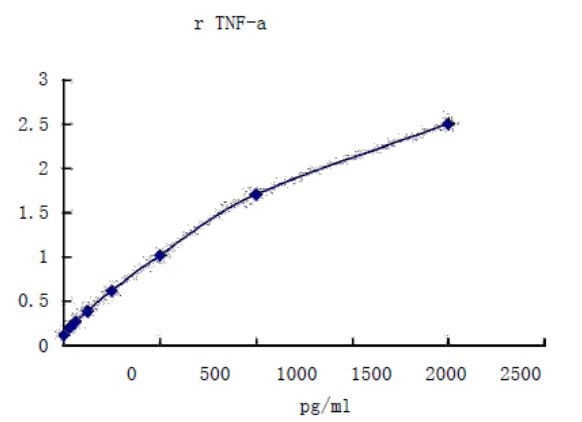The prototype ligand of theTNFsuperfamily, TNF-α/TNFSF1A, is a pleiotropic cytokine that plays a central role in inflammation and apoptosis (1-4).TNF-α is produced by activated macrophages and other cell types including T and B cells, NK cells, LAK cells, astrocytes, endothelial cells, smooth muscle cells and some tumor cells (5-8).
Rat TNF-α cDNA encodes a 235 amino acid (aa) residue type II membrane protein (9). The 156 aa residue soluble TNF-αis released from the C-terminus of the membrane-anchored TNF-α by TNF-α-converting enzyme (TACE), a matrix metalloprotease (10).
The membrane-anchored form of TNF-α has been shown to have lytic activity and may also have an important role in intercellular communication (11). The biologically active TNF-α has been shown to exist as a trimer (12, 13).TNF-α is reported to promote inflammatory cell infiltration by upregulating leukocyte adhesion molecules on endothelial cells, serve as a chemotactic agent for monocytes, and activate phagocyte killing mechanisms (14). Deficiencies in either TNF-α or its receptors can increase susceptibility to infection by intracellular pathogens (15-16). TNF-α may also play a role in lymphoid tissue development. Knockout mice lack splenic B cell follicles and the ability to form germinal centers (17, 18). Other potential physiological roles for TNF-α and its receptors include regulating the differentiation of hematopoietic stem and progenitor cells (19-21).
Kwon, B. et al. (1999) Curr. Opin. Immunol. 11:340.
Idriss, H.T. and J.H. Naismith (2000) Microsc. Res. Tech. 50:184.
Sedgwick, J.D. et al. (2000) Immunol. Today 21:110.
MacEwan, D.J. (2002) Brit. J. Pharmacol. 135:855.
Vilcek J. and T.H. Lee (1991) J. Biol. Chem. 266:7313.
Ruddle, N.H. (1992) Curr. Opinion Immunol. 4:327.
Tumor Necrosis Factor: Structure, Function and Mechanism of Action, Aggarwal, B.B. and J. Vilcek eds. (1991) Marcel Dekker, Inc., New York.
Beutler, B. and A. Cerami (1989) Annu. Rev. Immunol. 7:625.
Kwon, J. et al. (1993) Gene 132:227.
Gearing, A.J.H. et al. (1994) Nature 370:555.
Pennica, D. et al. (1985) Proc. Natl. Acad. Sci. USA 82:6060.
Gearing, A.J.H. et al. (1994) Nature 370:555.
Perez, C. et al. (1990) Cell 63:251.
Jones, E.Y. et al. (1989) Nature 338:225.
Eck, M.J. and S.R. Sprang (1989) J. Biol. Chem. 264:17595.
Wang, C.Y. et al. (1998) Science 281:1680.
Peschon, J.J. et al. (1998) J. Immunol. 160:943.
Wellmer, A. et al. (2001) Infect. Immun. 69:6881.
Trevejo, J.M. et al. (2001) Proc. Natl. Acad. Sci. USA 98:12162.
Kasahara, S. et al. (2003) J. Virol. 77:2469.
Pasparakis, M. et al. (1996) J. Exp. Med. 184:1397.
mmune-defensive microspheres promote regeneration of the nucleus pulposus by targeted entrapment of the inflammatory cascade during intervertebral disc degeneration In Bioact Mater on 2024 Mar 20 by Liang Zhou , Feng Cai et al..PMID: 38549774, , (2024)

